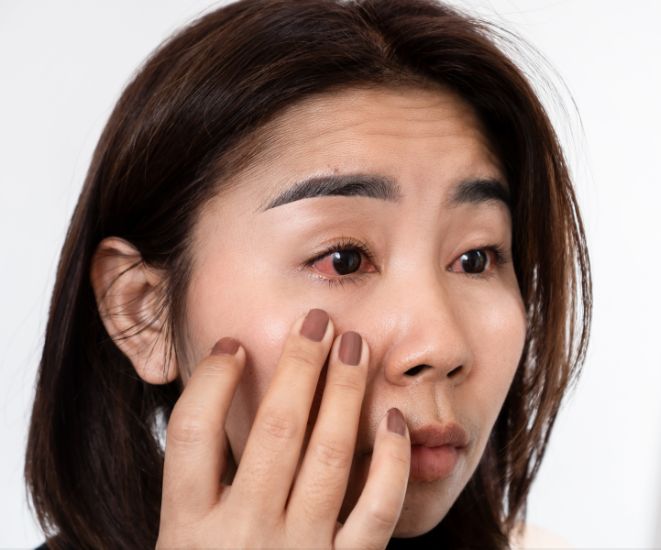Get Relief for Dry Eyes
Thankfully, there are many options when it comes to treatment for dry eyes. To help, there's Restasis, a medication used to treat dry eye disease.
Restasis
Restasis works by reducing inflammation in the tear glands, which helps them produce more natural tears. Unlike artificial tears that provide temporary relief, Restasis targets the root cause of reduced tear production.
It is typically used twice daily and may take several weeks to show noticeable improvement. This treatment is especially helpful for people with dry eye caused by conditions like Sjögren's syndrome or other inflammatory disorders.
1. Prescription Medications
Prescription medications can be effective in treating the underlying causes of dry eyes. Several options can help reduce inflammation, stimulate tear production and improve tear quality:
- Xiidra (Lifitegrast): Xiidra is a prescription eye drop specifically approved to treat the signs and symptoms of chronic dry eye disease. This medication works by blocking a protein interaction that causes inflammation in the eyes, which is often an underlying cause of dry eyes. Xiidra is typically used twice daily and can reduce symptoms in just a few weeks. Although it may cause some mild side effects, such as an unusual taste or slight irritation, many patients find significant relief with regular use. For those with moderate to severe dry eyes, Xiidra is a reliable option that targets inflammation, helping to restore comfort and moisture to the eyes.
- Miebo (Perfluorohexyloctane Ophthalmic Solution): Miebo targets the lipid (oil) layer to prevent tears from evaporating too quickly. Unlike many other dry eye treatments, Miebo directly addresses the cause of tear film instability associated with meibomian gland dysfunction, a common cause of dry eyes.
- Restasis (Cyclosporine): Another commonly prescribed eye drop for dry eye treatment is Restasis. Similar to Xiidra, it works by reducing inflammation and boosting natural tear production. Restasis is usually prescribed for people whose tear production is reduced due to inflammation and can take several weeks to show improvement. It is often recommended for chronic cases where the tear glands are not producing enough natural lubrication for the eyes.
Related Search Topics (Ads)
2. Over-the-Counter Remedies
For many people, over-the-counter (OTC) options offer an initial way to manage dry eye symptoms. Artificial tears or lubricating eye drops are the most common OTC remedy, as they provide moisture and help keep the eyes hydrated. Some popular artificial tear options include preservative-free varieties, which are often gentler on the eyes, especially for those needing frequent applications.
OTC ointments or gels are thicker than drops and offer longer-lasting relief, particularly for nighttime use. However, if these do not provide enough relief or if symptoms persist, it’s essential to consult an eye care specialist to explore further treatment options.
3. Punctal Plugs
For people who experience a quick evaporation of tears, punctal plugs can be an effective solution. These tiny, biocompatible devices are inserted into the tear ducts to help prevent tears from draining away too quickly. By retaining moisture on the eye’s surface, punctal plugs help keep the eyes hydrated for longer periods, reducing dryness and irritation. There are temporary and permanent plugs, and the choice depends on the severity of symptoms and individual preferences. Punctal plugs are generally painless and can provide lasting relief.
4. Warm Compresses and Eyelid Hygiene
Dry eyes can sometimes result from meibomian gland dysfunction (MGD), a condition where the oil-producing glands along the edge of the eyelids become blocked, leading to rapid tear evaporation. In these cases, warm compresses and proper eyelid hygiene can significantly alleviate symptoms. Applying a warm, moist cloth to closed eyes for a few minutes helps melt the oil buildup, allowing for better tear film stability. Regularly cleaning the eyelids and using eyelid scrubs or gentle cleansers can also prevent blockages and improve tear quality.
5. Omega-3 Supplements
Studies have shown that omega-3 fatty acids, found in fish oil and flaxseed oil, can help reduce dry eye symptoms by promoting a healthier tear film and reducing inflammation. Omega-3 supplements are readily available and may complement other treatments for dry eyes, especially for those experiencing mild to moderate symptoms. Adding more omega-3-rich foods, like salmon, walnuts and chia seeds to your diet can also be beneficial.
6. Moisture-Chamber Glasses
For individuals who experience dry eyes in specific environments, such as those with air conditioning, heating or windy climates, moisture-chamber glasses can help retain moisture around the eyes. These glasses have a specialized frame that limits airflow around the eyes, reducing tear evaporation. They are available in various styles and can be worn during daily activities, making them a versatile solution for managing dry eyes in challenging environments.
7. Lifestyle Adjustments and Environmental Changes
Certain lifestyle adjustments can help alleviate dry eyes and prevent symptoms from worsening. Reducing screen time, taking frequent breaks and following the 20-20-20 rule (looking 20 feet away for 20 seconds every 20 minutes) can help reduce eye strain. Additionally, using a humidifier to add moisture to indoor air and avoiding direct exposure to fans or air vents can prevent tears from evaporating too quickly.
8. Autologous Serum Eye Drops
In severe cases of dry eye disease that do not respond to other treatments, autologous serum eye drops may be recommended. These are made from the patient’s own blood, with the serum portion separated and used to create drops rich in natural growth factors and healing properties. Autologous serum eye drops can be particularly helpful for patients with chronic, unresponsive dry eye disease.

